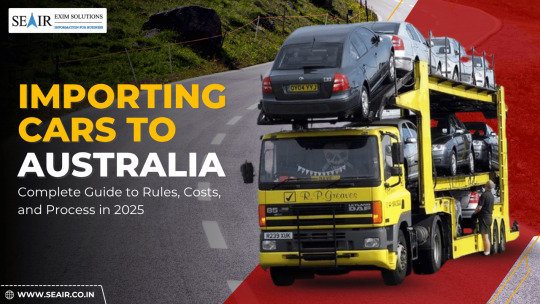#AutoTradeData
Explore tagged Tumblr posts
Text
Importing Cars to Australia in 2025: A Complete Guide
Australia continues to be one of the world’s most lucrative automobile import markets, importing vehicles worth billions of dollars annually. Whether you're relocating, a car enthusiast, or a dealer, understanding how to import a car into Australia in 2025 is crucial. From legal requirements and import schemes to cost breakdowns and top car models, this guide provides everything you need to know before shipping a vehicle to the Land Down Under.

Top Car HS Codes and Brands Imported to Australia
When importing cars to Australia, it’s essential to know the Harmonized System (HS) Codes. Here are the most commonly used codes:
8703 – Motor cars for transport of persons
87038030 – Electric vehicles
87031090 – Three-wheeled motor cars
870321 – Cars with spark-ignition engines (≤ 1,000 cc)
Popular Imported Car Brands in Australia:
Daihatsu
Honda
Lexus
Mazda
Mitsubishi
Nissan
Subaru
Suzuki
Understanding the Legal Framework: Regulations & Approvals
Australia enforces strict car import regulations under the Road Vehicle Standards Act 2018 (RVSA). All vehicle imports must be approved through the ROVER system (Road Vehicle Regulator).
Key Regulatory Authorities:
Department of Infrastructure, Transport, Regional Development, Communications and the Arts – Vehicle import approvals
Australian Border Force (ABF) – Customs and duties
Department of Agriculture, Fisheries and Forestry (DAFF) – Biosecurity inspections
State/Territory Road Agencies – Vehicle registration and compliance
Top Car Imports from the USA to Australia
Many Australians prefer importing American muscle and performance cars. The most popular US imports include:
Ford Mustang
Chevrolet Camaro
Dodge Charger
To import these vehicles, compliance with Australian Design Rules (ADRs), safety, and emissions standards is mandatory.
Detailed Australia Car Import Data (2024–2025)
By Value:
According to Seair Exim Solutions, Australia imported $368.22 billion worth of vehicles in the fiscal year 2024–2025.
Top Car Exporting Countries to Australia (2023):
Japan – $8.53 billion
China – $4.37 billion
South Korea – $3.32 billion
Germany – $1.98 billion
Thailand – $1.61 billion
Australia ranked as the 9th largest car importer globally, with cars being its second most imported product.
Why Import a Car to Australia?
Access to rare or collector models unavailable locally
Potential cost savings due to currency exchange or lower prices abroad
For relocating migrants or expatriates returning to Australia
Passionate car collectors and performance car enthusiasts
Car Import Schemes for 2025
1. SEVS Scheme (Specialist & Enthusiast Vehicle Scheme)
For vehicles not sold locally
Must be listed on the SEVS Register
Imported by Registered Automotive Workshops (RAWS)
2. Personal Import Scheme
Vehicle must have been owned and used overseas for 12+ months
Ideal for migrants and returning residents
3. Older Vehicle Scheme
Vehicles 25 years or older
Fewer safety and emissions requirements
4. Exhibition, Rally & Race Vehicles
Temporary or permanent importation for specific non-road purposes
Step-by-Step: How to Import a Car to Australia
Step 1: Apply for Vehicle Import Approval (VIA)
Register for a ROVER account
Pay a fee (typically $50–$100)
Step 2: Determine Import Scheme Eligibility
Use the Vehicle Import Tool
Check SEVS or Personal Import criteria
Step 3: Arrange Shipping
RoRo (Roll-on/Roll-off) or Container shipping
Costs: AUD $2,000–$5,000+
Step 4: Get Customs Clearance
Documents: Bill of Lading, VIA, ownership proof, declaration of value
Inspections by DAFF for quarantine risks
Step 5: Compliance and Modifications
Testing, vehicle modifications (if needed), and RAV listing
Step 6: Register the Vehicle
Managed by state authorities
Requires safety inspection, registration fee, and issuance of plates
Costs Involved in Importing a Car to Australia (2025)
ItemEstimated Cost (AUD) Shipping & Freight $2,000 – $5,000+ Vehicle Import Approval (VIA) $50 – $100 Import Duty 5% of vehicle’s customs value GST 10% (vehicle value + duty) Luxury Car Tax (if applicable) 33% over threshold ($69,152–$76,950) Customs Broker Fee (optional) $400 – $800 Biosecurity Inspection $80 – $200 Compliance Modifications $1,500 – $4,000+ Registration & Stamp Duty Varies by state ($500 – $2,000)
Temporary Vehicle Importation
Cars can be temporarily imported into Australia for up to 12 months under a Carnet de Passages en Douane (CPD), suitable for:
Tourists
Temporary residents
Motorsports events
Required Documents for Car Import
Vehicle Import Approval (VIA)
Photo ID
Ownership & registration documents
Bill of lading
Declaration of value
Insurance and quarantine compliance documents
Carnet (if temporarily imported)
Customs clearance forms
Where to Find Australia Car Import Data
To access detailed Australia car import data, consider using Seair Exim Solutions, which offers:
Import/export data
Car HS code listings
Trade stats from 120+ countries
Forecasts and shipment tracking
Australian importer directories
Final Thoughts
Importing a car into Australia in 2025 involves many legal and procedural steps, but with the right knowledge, it can be a highly rewarding endeavor. Whether you're importing a classic muscle car or a rare Japanese model, compliance and preparation are key.
If you need help with the documentation, finding car importers, or understanding customs rules, Seair Exim Solutions offers a robust platform for tracking data, trends, and buyers. Schedule your free demo and access the latest insights on Australia's automotive trade today.
#CarImportAustralia#AustraliaImport2025#SeairEximSolutions#VehicleImportApproval#AustralianCarMarket#CarShippingAustralia#CustomsClearance#SEVS#CarImportCost#AutoTradeData
0 notes